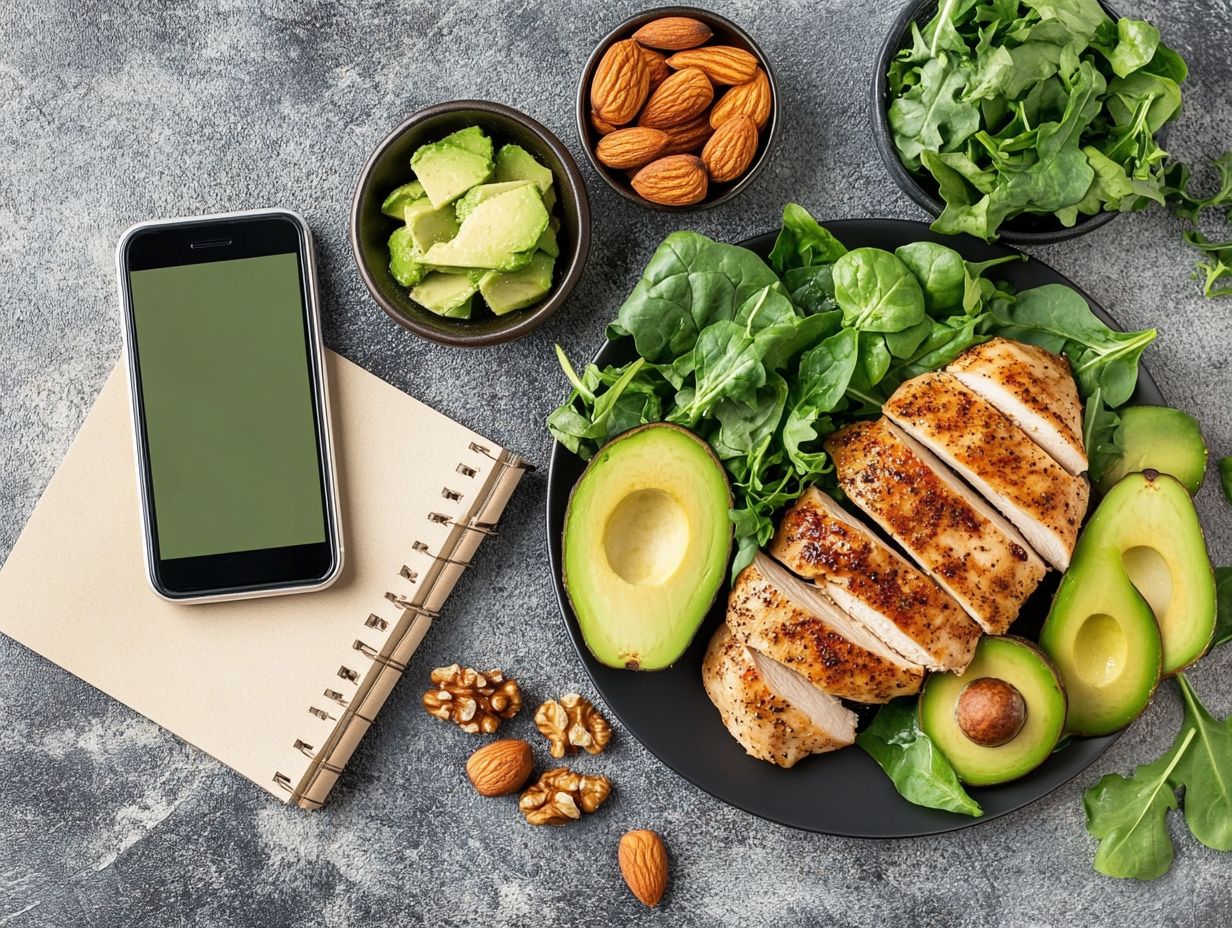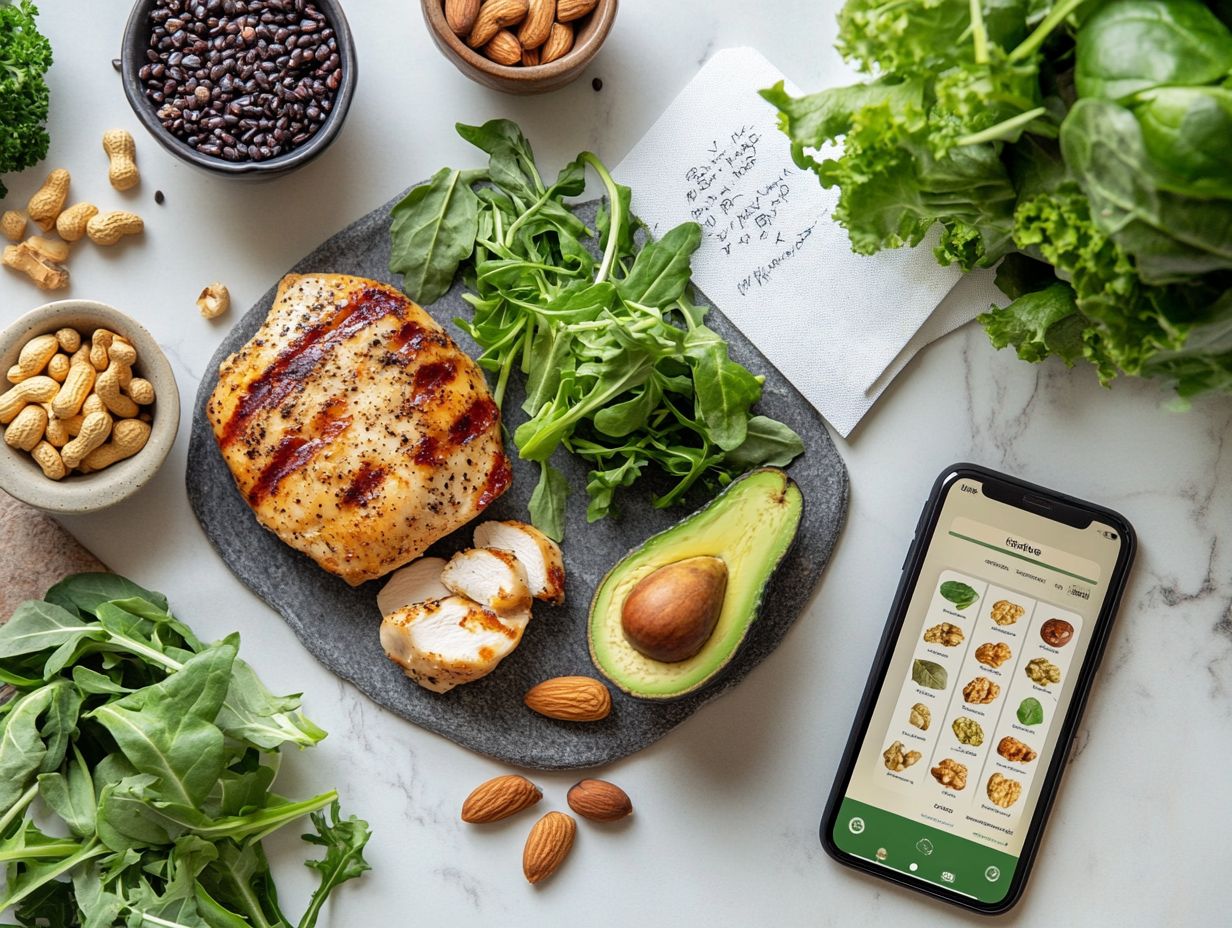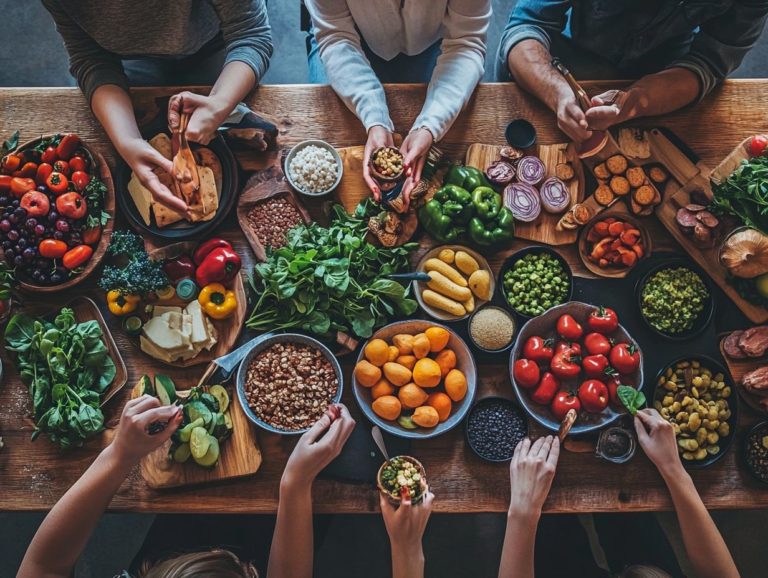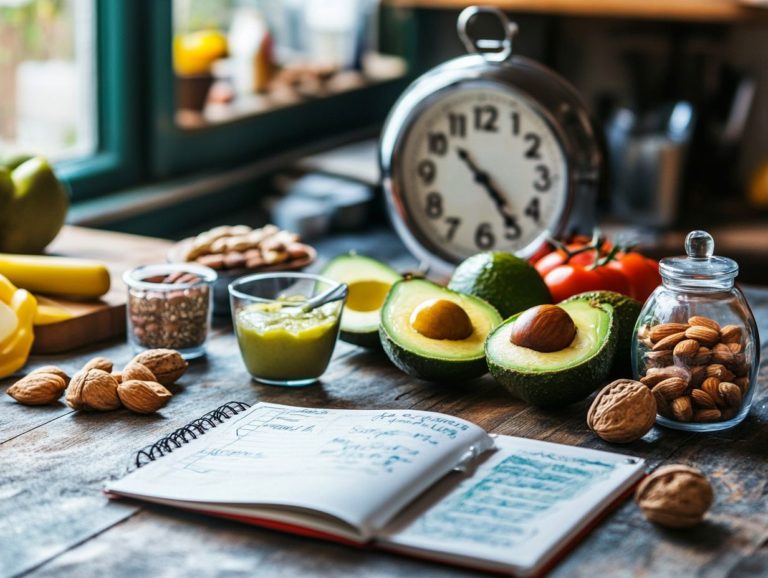How to Stay on Track with Keto: Common FAQs
The Keto Diet has become a sensation in the health and wellness arena, presenting a low-carb, high-fat approach that promises not just weight loss but also enhanced energy levels. This popular diet has been endorsed by the Epilepsy Foundation for its benefits in managing epilepsy.
This diet introduces a distinctive way of eating, emphasizing particular food selections tailored to your goals. Incorporating nutritional information and understanding dietary restrictions can help achieve optimal results.
Uncover the mechanics of the keto diet, explore the delicious foods you can indulge in, and identify those you should steer clear of based on carb counting.
Dive into common pitfalls, gather insightful tips for maintaining your course, and find answers to frequently asked questions, equipping yourself with everything you need to embark on your keto journey confidently. Long-term studies and expert advice from Scott Keatley and Kendra Whitmire can enhance understanding of this lifestyle.
Contents
- Key Takeaways:
- What is the Keto Diet?
- What Foods Can You Eat on the Keto Diet?
- What Foods Should You Avoid on the Keto Diet?
- What Are Some Common Keto Diet Mistakes?
- How Do You Stay on Track with the Keto Diet?
- How Do You Handle Social Events and Eating Out on the Keto Diet?
- How Do You Handle Cravings on the Keto Diet?
- How Do You Stay Motivated on the Keto Diet?
- Common FAQs About the Keto Diet
- The Keto Diet: Insights and Tips
Key Takeaways:
- Stick to high-fat, moderate protein, and low-carb foods to maintain ketosis.
- Plan ahead for social events by researching keto-friendly options and staying strong against cravings.
- Consult a healthcare professional before starting the keto diet and be aware of potential side effects, including keto flu.
What is the Keto Diet?
The keto diet, often referred to as the ketogenic diet, is an elevated approach to nutrition that focuses on high fat and low carbohydrates. Designed to facilitate weight loss and enhance overall health, it induces a metabolic state known as ketosis, a state where your body burns fat instead of sugar for energy. The Mayo Clinic has also highlighted its potential benefits for heart health and obesity management.
In this state, your body shifts gears, burning fat for fuel instead of relying on carbohydrates. This leads to remarkable changes in your body weight and composition. This diet prioritizes healthy fats and encourages moderate protein intake, while minimizing carbohydrate consumption. This makes it an appealing option for those seeking effective weight management while accommodating various dietary preferences. It has also shown promise in managing conditions like polycystic ovary syndrome and heart disease.
Supported by experts from renowned institutions like the Mayo Clinic, the keto diet has gained traction for its potential benefits in heart health and beyond.
How Does the Keto Diet Work?
The keto diet operates by significantly cutting back on carbohydrates and replacing them with healthy fats, ushering your body into a state known as ketosis. In this metabolic state, your body becomes exceptionally efficient at burning fat for energy, which is particularly beneficial for individuals managing blood sugar levels.
The liver steps up to convert fats into ketones, which serve as a vital alternative energy source when glucose is in short supply. This process is supported by research in the Journal of Clinical Endocrinology and Nutrition Metabolism.
This transformative process redefines your metabolic pathways by shifting the primary energy source from carbohydrates to fats. It fundamentally alters how your body taps into stored energy. Balancing your macronutrients is key. Healthy fats should dominate your dietary intake, accompanied by an adequate amount of protein to preserve muscle mass and support vital metabolic functions. To further support these dietary changes, some individuals may consider exogenous supplements.
Research from the Mayo Clinic indicates that as you transition into ketosis, you might encounter various health implications. This includes initial fatigue or what’s often referred to as keto flu, as your body adjusts. However, many individuals report enhanced mental clarity and sustained energy levels once they’ve fully transitioned. Factor Meals and Everyday Health also offer practical advice on managing these initial symptoms effectively.
To achieve optimal results without compromising your health, regularly monitoring your fat and protein intake is essential.
Ready to start your keto journey? Gather more information and take the next step toward a healthier you!
What Foods Can You Eat on the Keto Diet?
When you embark on a keto diet, your focus shifts to indulging in foods abundant in healthy fats while keeping carbohydrates to a minimum. Picture avocados, nuts, and beef jerky as your new go-to staples, recommended by nutritionists like Kelly Kennedy and Jessica Migala.
This dietary strategy not only emphasizes the importance of meal planning but also ensures that your meals are crafted around high-fat, low-carb options. By doing so, you can maintain balanced nutrition while effortlessly staying in a state of ketosis, supporting overall health and minimizing health risks.
What Are Some Keto-Friendly Snack Options?
Keto-friendly snacks offer a delightful array of healthy options that perfectly align with the principles of a low-carb diet. Think of avocados, cheese, and nuts. These snacks are not only delicious but also packed with essential nutrients while keeping your carbohydrate intake delightfully low.
Incorporating these snacks into your daily routine is easy and fun! For instance, slice an avocado and add a sprinkle of salt and pepper for a quick, satisfying bite. Cheese sticks are a fantastic option, perfect for those on-the-go moments when you need something convenient yet nutritious. Staying hydrated is crucial to maximizing the benefits of these healthy options.
Nuts, like almonds and walnuts, serve as an excellent source of healthy fats and provide that satisfying crunch to help curb cravings between meals. Prepare snack packs in advance to streamline your choices throughout the week, making it easier to adhere to your low-carb lifestyle.
Having these nutritious snacks readily available encourages healthier eating habits and supports sustained energy levels, enhancing your overall well-being. These practices are essential for those managing conditions like heart disease and obesity.
What Are Some Keto-Friendly Meal Options?
Keto-friendly meal options can truly elevate your dining experience, offering a delightful array of dishes. Picture grilled chicken paired with a creamy avocado salad or zucchini noodles adorned with rich, high-fat sauces. Emphasizing meal planning is key to maintaining your commitment to a high-fat diet, ensuring you get ample protein while keeping carbohydrates at bay. Incorporating intermittent fasting into your routine can also amplify these benefits.
Vibrant dishes such as salmon with asparagus drizzled in olive oil or a hearty spinach and cheese omelet can transform any meal plan. Preparing meals in bulk and opting for healthy fats like coconut oil or butter enhances flavors and infuses essential nutrients into your diet.
To support your successful keto lifestyle, consider crafting weekly menus featuring convenient snacks like cheese sticks or nuts. This strategic foresight ensures you always have keto-friendly options on hand, making it easier to resist high-carb temptations and stay aligned with your overarching goal of improving health through a well-rounded ketogenic approach.
What Foods Should You Avoid on the Keto Diet?
On the keto diet, it’s essential to steer clear of foods high in carbohydrates to maintain a smooth state of ketosis. Allowing these carbs into your diet can disrupt this metabolic state, potentially leading to health risks and the unwelcome symptoms commonly known as ‘keto flu.’
This means avoiding sugary treats, grains, and certain fruits that could undermine the diet’s effectiveness. Be mindful of health risks associated with consuming these foods. Your commitment to these guidelines will ensure you stay on track and enjoy the benefits of keto living.
Start your keto journey today with these delicious meals!
What Are Some Common Keto Diet Mistakes?
As you embark on the keto diet, be mindful of some common pitfalls that can derail your weight loss journey and overall success. These include miscalculating your carb intake, neglecting hydration, and failing to balance your carbohydrates, proteins, and fats. If you’re not prepared for the initial transition, you might experience fatigue or even fall victim to the dreaded ‘keto flu.’
To combat these issues, consider consulting experts like Scott Keatley and Kendra Whitmire. To navigate this journey more smoothly, it’s essential to familiarize yourself with the dietary limitations and optimal food choices before diving in.
The overwhelming array of options can lead to confusion, resulting in poor food selections and missed chances to maintain ketosis. Planning your meals ahead of time can effectively tackle this challenge and help curb cravings.
Staying adequately hydrated is critical, as dehydration is a common issue during this low-carb lifestyle. By prioritizing hydration and mastering your macronutrient ratios, you’ll find it far easier to stick to keto principles. This will ultimately pave the way for sustainable and impressive results.
How Do You Stay on Track with the Keto Diet?
Staying on track with the keto diet can be challenging, but with the right guidance and resources, you can achieve success. Consulting long-term studies and experts like Kelly Kennedy can provide valuable insights.
To remain on course with the keto diet, you need to blend effective meal planning with healthy choices. Often, incorporating strategies like intermittent fasting can amplify your results. Understanding your dietary restrictions and consistently monitoring your progress are also crucial.
Remember, consistency and preparation are critical elements in maintaining ketosis and reaching your long-term weight loss aspirations.
How Do You Handle Social Events and Eating Out on the Keto Diet?
Navigating social events and dining out while on the keto diet can indeed pose some challenges, but with strategic meal planning and a solid understanding of healthy options, you can enjoy these occasions without missing a beat!
Opting for restaurants that feature keto-friendly dishes will make the experience much smoother. Websites like Everyday Health offer practical tips for dining out while adhering to keto guidelines.
When searching for restaurants, aim for those with a varied menu that highlights grilled meats, fresh vegetables, and healthy fats—key components of the keto lifestyle. Utilizing websites and apps dedicated to dietary preferences can be incredibly beneficial. These resources help you pinpoint suitable venues in advance, ensuring your choices align with keto guidelines.
Don’t shy away from sharing your dietary preferences with the staff; they are often quite accommodating and can suggest modifications or create meals tailored to your nutritional objectives. By planning ahead and confidently expressing your needs, you can transform social dining into a delightful experience that complements your keto lifestyle.
How Do You Handle Cravings on the Keto Diet?
Handling cravings on the keto diet requires a proactive mindset. You can incorporate healthy options that satisfy your urges without compromising ketosis, all while ensuring you stay adequately hydrated to support your overall health and weight loss goals.
Recognizing your triggers and preparing alternatives can significantly aid you in this journey. One effective strategy is to keep a variety of keto-friendly snacks at your fingertips, such as nuts, cheese, or celery with almond butter.
These options not only nourish your body but also help curb those intense cravings that can derail your progress. Drinking plenty of water throughout the day is essential; it helps you stay hydrated and can prevent you from mistaking thirst for hunger—a common pitfall for many.
Adding herbal teas or lemon water can introduce a burst of flavor without any carbs, making your hydration routine both enjoyable and beneficial. By prioritizing these constructive practices, you can navigate your cravings with greater ease within the keto framework, ultimately enhancing your journey toward healthier eating habits.
How Do You Stay Motivated on the Keto Diet?
Staying motivated on the keto diet is all about setting realistic weight loss goals and refreshing your meal plans with healthy options that keep boredom at bay. Engaging with long-term studies and connecting with the keto community can significantly enhance your motivation.
Incorporating educational resources—like insightful articles, engaging podcasts, and informative video tutorials—can provide you with valuable insights into successful keto practices and empower you to make informed decisions. Joining online forums or local support groups can create a sense of belonging and accountability, making it easier to share both your successes and challenges.
Setting mini-goals, celebrating your milestones, and remaining flexible with your expectations will help you maintain focus and resilience throughout your journey. By adopting a proactive approach to learning and getting involved in the community, you can significantly elevate your motivation on the keto diet.
Common FAQs About the Keto Diet
Common FAQs about the keto diet cover a variety of topics that can shed light on its core principles while addressing any potential health risks. You might find yourself pondering issues such as the keto flu, the safety of intermittent fasting, and the timeline for seeing weight loss results.
These questions are vital for gaining a comprehensive understanding of the diet and its implications for your health.
Can You Have Cheat Days on the Keto Diet?
The topic of cheat days on the keto diet often raises intriguing questions about their influence on ketosis and weight loss outcomes. Many experts caution that these indulgences can jeopardize your metabolism and pose potential health risks.
Some nutritionists advocate for the occasional cheat day as a much-needed psychological reprieve from the strict keto regimen. This allows you to partake in social gatherings without the nagging feeling of deprivation! Embracing this flexible approach may help you avoid binge eating episodes that can result from prolonged adherence to a strict diet.
Yet, it’s crucial to recognize that indulging in high-carb foods can yield varying effects. If not managed wisely, it might temporarily disrupt fat burning and lead to feelings of guilt.
Finding a balance between discipline and indulgence can help you stay committed to the diet.
Is the Keto Diet Safe for Everyone?
While the keto diet boasts a range of potential health benefits, it’s crucial for you to assess its safety on a personal level. Individual dietary restrictions and health risks may play a significant role in determining whether this high-fat, low-carb lifestyle is right for you, as experts from the Mayo Clinic and other reputable health sources suggest.
If you have pre-existing health conditions like diabetes, liver disease, or heart issues, it’s wise to proceed with caution. Medical professionals typically advise that you consult with healthcare providers before diving into the keto diet, as it can profoundly impact your metabolism.
If you’re pregnant or breastfeeding, this diet might not be ideal, given the risk of potential nutritional deficiencies stemming from its restrictive nature. Conversely, certain groups, such as those dealing with epilepsy, could find therapeutic benefits in the keto approach, indicating that the diet’s safety and effectiveness can vary significantly based on your unique health profile.
The Keto Diet: Insights and Tips
What Are Some Common Side Effects of the Keto Diet?
Common side effects of the keto diet may include symptoms often referred to as the ‘keto flu’, such as headaches, fatigue, and nausea, particularly during your initial transition into ketosis. This highlights the importance of staying adequately hydrated and ensuring proper nutrient intake during this crucial period.
As your body adjusts to burning fat for fuel rather than carbohydrates, you might notice imbalances in electrolytes, which can lead to potential dizziness, muscle cramps, and irritability. These reactions can complicate your dietary adjustment.
To effectively manage these side effects, increase your salt intake, stay well-hydrated, and consider supplementation with magnesium and potassium. Gradually reducing your carbohydrate intake instead of making an abrupt switch can help ease this transition and alleviate uncomfortable symptoms, paving the way for a smoother entry into the ketogenic lifestyle.
How Long Does It Take to See Results on the Keto Diet?
How quickly you see results can vary. Many people start noticing weight loss within the first week, while long-term studies indicate that sticking with the diet can lead to more significant changes in body composition and overall health improvements over time.
Several factors can influence this timeline, including your starting weight, metabolic rate, activity level, and how closely you adhere to the diet’s principles. For example, if you have a higher initial body fat percentage, you might see more noticeable weight loss initially than someone with less.
The body’s adaptation to ketosis is key—it could take anywhere from a few days to a couple of weeks for your body to shift from burning carbohydrates to fats as its primary fuel source. This transition is crucial to unlock the health benefits of the diet.
Beyond just weight loss, you may also experience improvements in energy levels, mental clarity, and reduced cravings, which can manifest at different intervals throughout your journey.
Can You Exercise on the Keto Diet?
Exercising while on the keto diet is not only encouraged but can also significantly enhance your weight loss journey. However, you may need to fine-tune your exercise routines to accommodate your body’s transition to using fat as its primary fuel source. This adjustment includes paying close attention to hydration and ensuring your energy levels are up to par.
As your body shifts from relying mainly on carbohydrates to utilizing fats for energy, it’s essential to understand that different types of workouts will yield different responses. For example, high-intensity workouts might initially feel more taxing due to lower glycogen stores, which could lead to fatigue arriving sooner than you’d like. Conversely, aerobic exercises often become easier over time as your body adapts to its new fuel source.
You should also consider upping your electrolytes and possibly adjusting your workout intensity and duration. These tweaks can help you maintain performance levels and overall health while fully benefiting from the keto diet.
Frequently Asked Questions
1. What is the keto diet and how does it work?
The keto diet is a high-fat, moderate-protein, and low-carbohydrate diet that forces the body to burn fat for energy instead of carbohydrates. This process is called ketosis and it helps with weight loss and improved energy levels.
2. How do I know if I’m in ketosis?
You can test for ketosis using urine strips or a blood ketone meter. Signs of being in ketosis include increased energy, mental clarity, and a decrease in appetite.
3. Can I have cheat days while on the keto diet?
While it’s not recommended to have regular cheat days on the keto diet, some people do incorporate occasional cheat meals. However, be aware that it can take several days for your body to get back into ketosis after a cheat meal.
4. Do I need to track my macros on the keto diet?
For the best results, it’s recommended to track your macros (carbohydrates, protein, and fat) while on the keto diet. This will help ensure that you stay within the appropriate ranges to achieve and maintain ketosis.
Curious about starting the keto journey? Check out our beginner’s guide!
5. Can I Eat Out While on the Keto Diet?
Yes, you can enjoy dining out while on the keto diet! Focus on protein-rich dishes and ask for substitutions instead of high-carb sides like potatoes or rice.
Many restaurants now offer keto-friendly options, making it easier to stick to your low-carb goals.
6. How Do I Avoid Keto Flu and Ketosis-Related Symptoms?
Keto flu is a common issue when starting the keto diet. Stay hydrated and replenish electrolytes with supplements.
Increase your intake of healthy fats, like avocados and nuts, and gradually reduce carbohydrates instead of cutting them out all at once. Also, keep an eye on your protein intake. For more guidance, check out resources like the Mayo Clinic!










